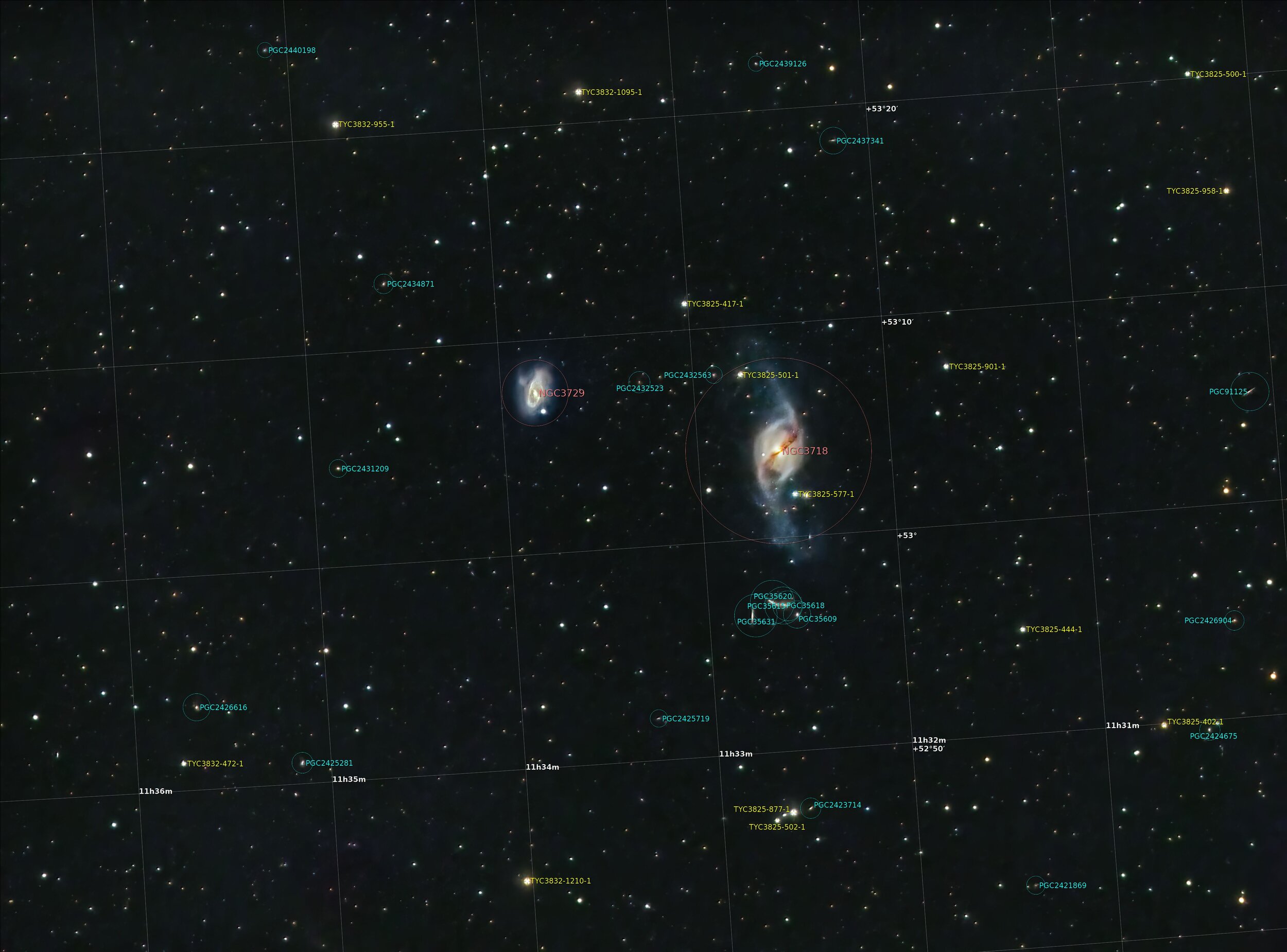NGC 3718 /ARP 214 - The Twisted Galaxy
Date: June 12, 2021
Cosgrove’s Cosmos Catalog ➤#0074
Table of Contents Show (Click on lines to navigate)
About the Target
NGC 3718, also known as ARP 214, is a distorted spiral galaxy in the constellation Ursa Major and is located about 59 Million Light Years away. Its distorted form is thought to be gravitational interaction with the other galaxy seen in this image - NGC 3729 - at some point in the distant past. These are all part of a group of galaxies known as the Ursa Major Cluster.
One interesting footnote - below NGC 3718 you can see a small grouping of elongated shapes, very close together. While not shown very well in this image, this is a small group of 5 galaxies known as Hickson 56. These Galaxies are estimated to be about 400 Million Light Years away!
About the Project
These galaxies are very far away and very small. The largest one here only measures 2.9" x 2.4" in size. I mention this because I really don't have a scope that is set up for these very small galaxies. SO why did I chose this target? Well, part of me wanted to see what I could do with it. Another part has to do with the fact that this time of year - the number of targets is a bit limited - especially what I can access due to the tree lines on my property.
This is the third and last image to come out of my 3-night imaging cycle starting on June 4th. While we had three clear nights, we also had some bands of thin clouds that came through and the overall sky transparency was far from great. The thin clouds are not enough to lose a guide star and disrupt your runs, but they can ruin the contrast on critical subframes. In this case, I had to remove roughly 1/2 of my subs and it reduced the number of Green frames I ended with to less than half what I had for the other channels.
When first processed this image - it looked pretty bad. So I went back to square one, and this time I spent a huge amount of time working on the image deconvolution step. Some people think of deconvolution as a "Sharpening" step. In fact, it does something quite different. Working in the frequency domain, it attempts to restore lost information caused by the optics. This is very tricky to use properly and for my first year of astrophotography, I could not get any good results out of this at all. Then I got some help from Gary Optiz and Dan Kutcha and I was able to follow a "recipe" and get some small advantages to my images. This time though, I really dug into it - played around with every parameter and saw how it impacted the image. At the end of it all, I had finally figured out how to use it properly, and I had a version of the linear image that had more detail than I had before.
With this, I went forward and processed the image doing the bulk of the work in Pixinsight, and then shifting to Photoshop for the last polishing phases. I also used Topaz Denoise AI, on a few trouble spots along the way.
In the end - I was happy with the final result - but I also knew that to get the results I really want here I need a few things: 1) a scope with more focal length and resolution 2) Clearer and more transparent skies. 3) and a lot more integration time.
The Annotated Image
The Location in the Sky
Capture Details
Lights
*Number of frames is after bad or questionable frames were culled.
53 x 120 seconds, bin 1x1 @ -15C, unity gain, ZWO Gen II L Filter
64 x 120 seconds, bin 1x1 @ -15C, Unity gain, ZWO Gen II R Filter
26 x 120 seconds, bin 1x1 @ -15C, unity gain, ZWO Gen II G Filter
46x 120 seconds, bin 1x1 @ -15C, unity gain, ZWO Gen II B Filter
Total of 6.3 hours
Cal Frames
30 Darks at 300 seconds, bin 1x1, -10C, gain 100
30 Darks at 90 seconds, bin 1x1, -10C, gain 0
30 L Flats
30 R Flats
30 G Flats
30 B Flats
50 Bias
Capture Hardware
Scope: William Optics 132mm F/7 FLT APO
Guide Scope: Sharpstar 66EDPHII
Camera: ZWO ASI1600mm-pro with ZWO Filter wheel with ZWO LRGB filter set,
and Astronomiks 6nm Narrowband filter set
Guide Camera: ZWO ASI290Mini
Focus Motor: Pegasus ZWO EAF 5V
Mount: Ioptron CEM 26
Polar Alignment: Ipolar camera
Software
Capture Software: PHD2 Guider, Sequence Generator Pro controller
Image Processing: Pixinsight, Photoshop - assisted by Coffee, extensive processing indecision and second-guessing, editor regret, and much swearing….. Given the problems on this image, more than the usual whining….




I was very excited to get the ZWO ASI2600MM-Pro camera a while back. I ordered it when it was announced and then prepared to wait a long time to get it. When I did get it - I decided to put it onto the AP130 platform. That meant that I could move the ZWO ASI1600MM-Pro, along with its filter wheel over to my William Optics Platform. This now means that all of the platforms have been moved over to a mono camera and my ZWOASI924MC-Pro is now not in use.